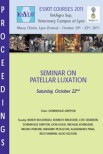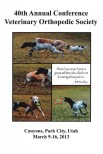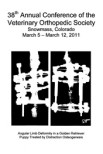The objective of this study was to evaluate the accuracy of ultrasonographic diagnosis of lesions in the canine stifle associated with cranial cruciate ligament rupture. Thirteen dogs that had a diagnosis of cranial cruciate ligament rupture were included in this prospective clinical study. Two ultrasonographers who were unaware of specific historical and clinical data performed the sonography with a high frequency (8-16 MHz) linear transducer. Surgical treatment of the affected stifle was performed within two days of ultrasonography by a surgeon who was unaware of the ultrasonographic findings. The lesions observed during ultrasonography and arthrotomy were compared at the completion of the study. Visualisation of the superficial tendons (quadriceps and long digital extensor) and ligaments (patellar ligament, collateral ligaments) of the stifle using ultrasonography was excellent. However, the detection of deep stifle ligaments (cranial cruciate ligament and caudal cruciate ligament) was extremely difficult to perform using ultrasonography. For cranial cruciate ligament rupture, the sensitivity for ultrasonographic diagnosis was 15.4%. For meniscal lesions, the sensitivity, specificity, positive and negative predictive values for ultrasonographic diagnosis were 82%, 93%, 90% and 88% respectively. High frequency ultrasonography is a non-invasive method for accurately and efficiently detecting superficial ligaments, tendons and meniscal lesions associated with cranial cruciate ligament rupture in the stifle of non-sedated dogs.
Diagnostic value of ultrasonography to assess stifle lesions in dogs after cranial cruciate ligament rupture: 13 cases.
Date
2009
Journal
VCOT
Volume
22
Number
6
Pages
479-85









